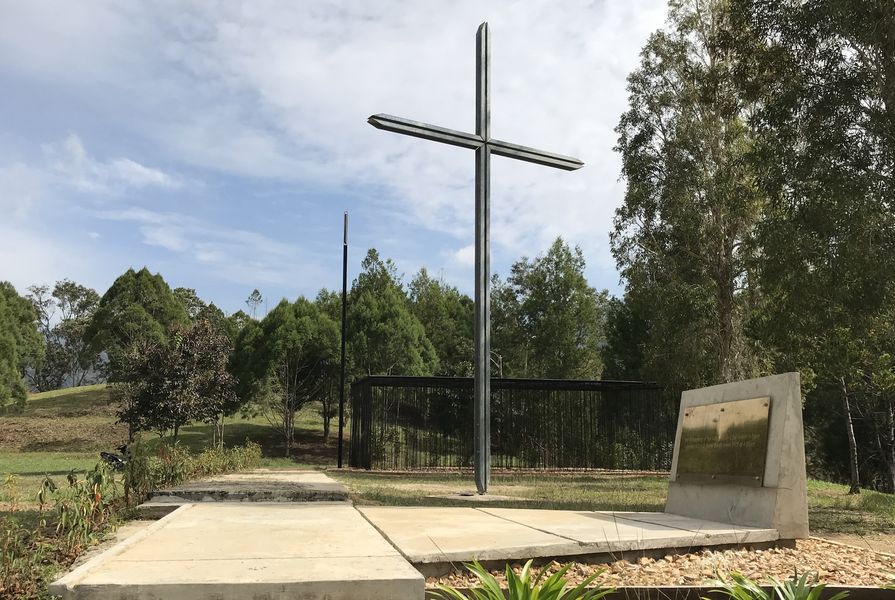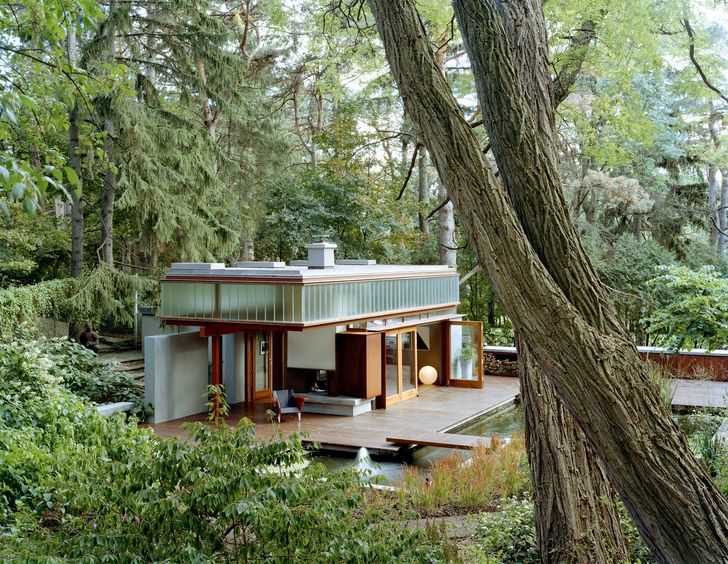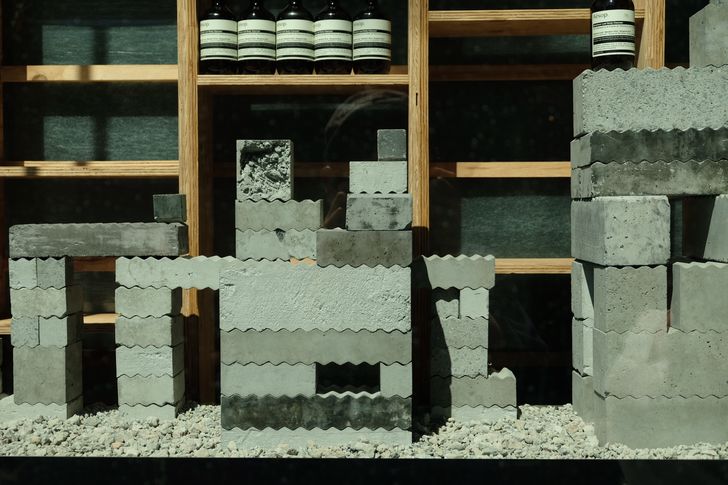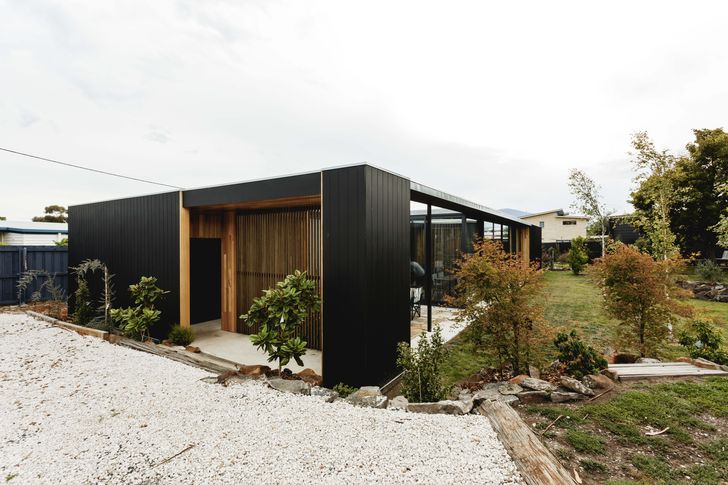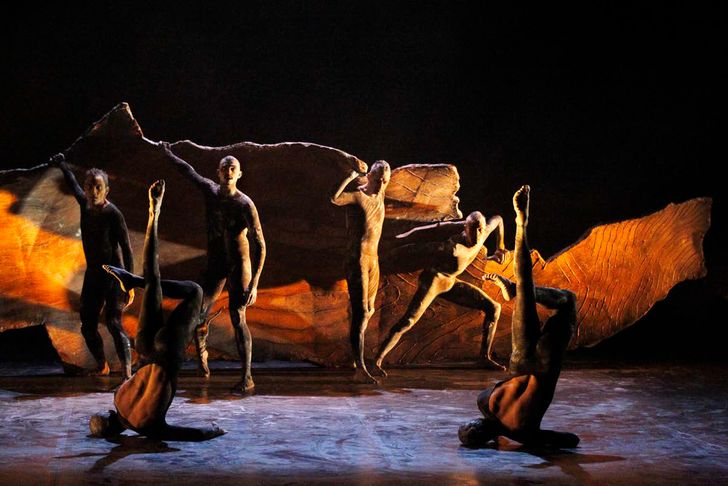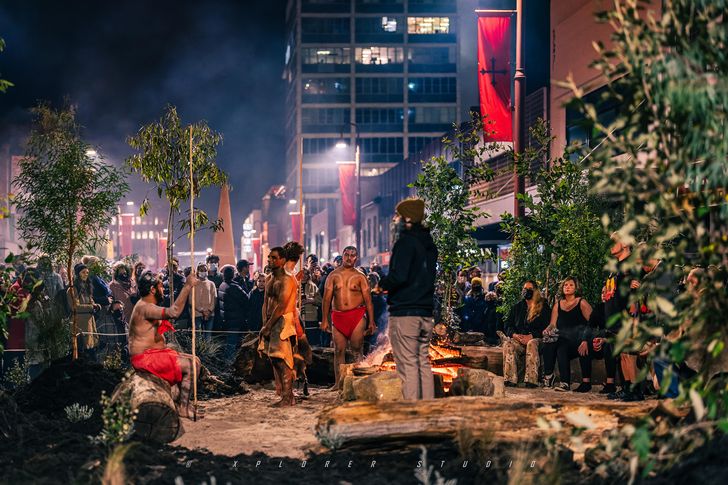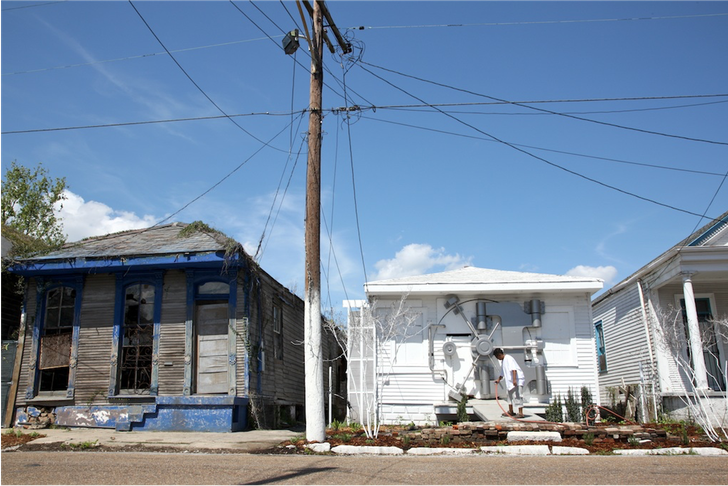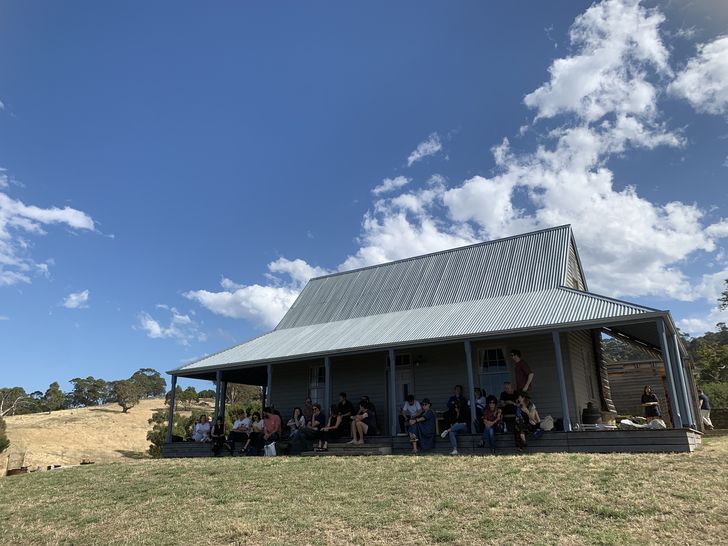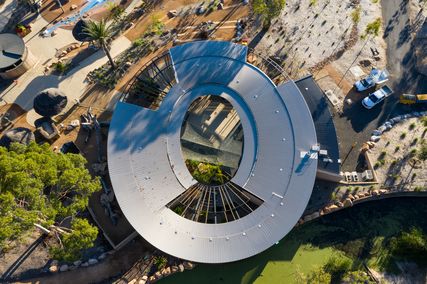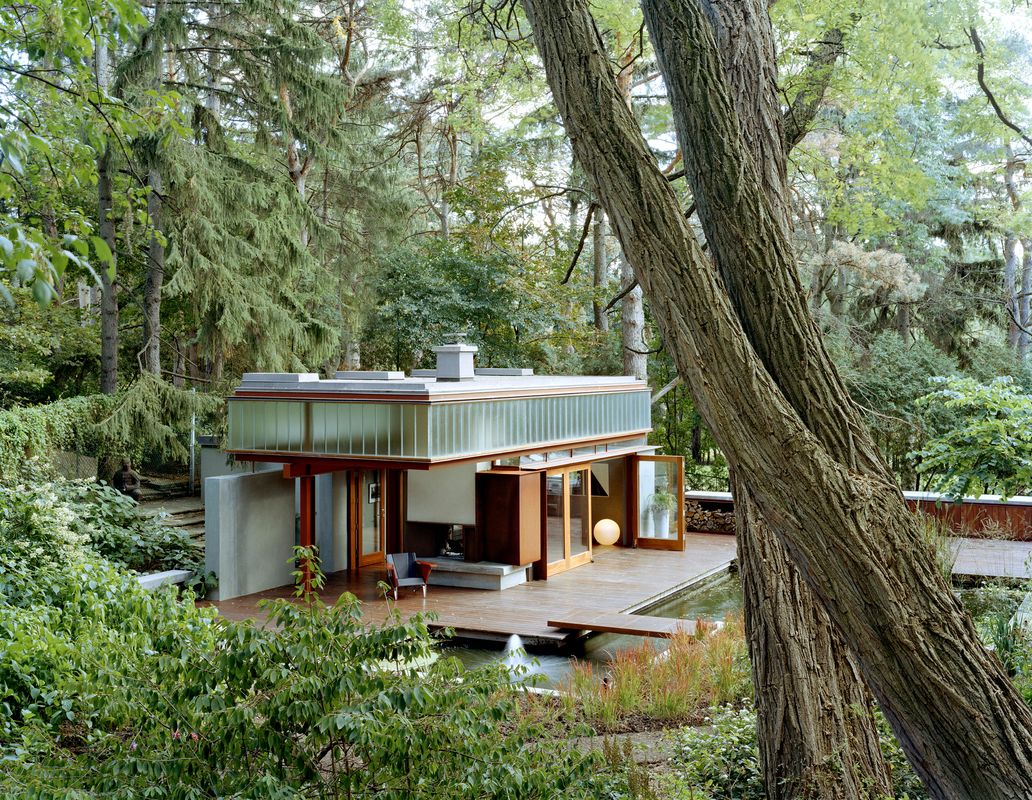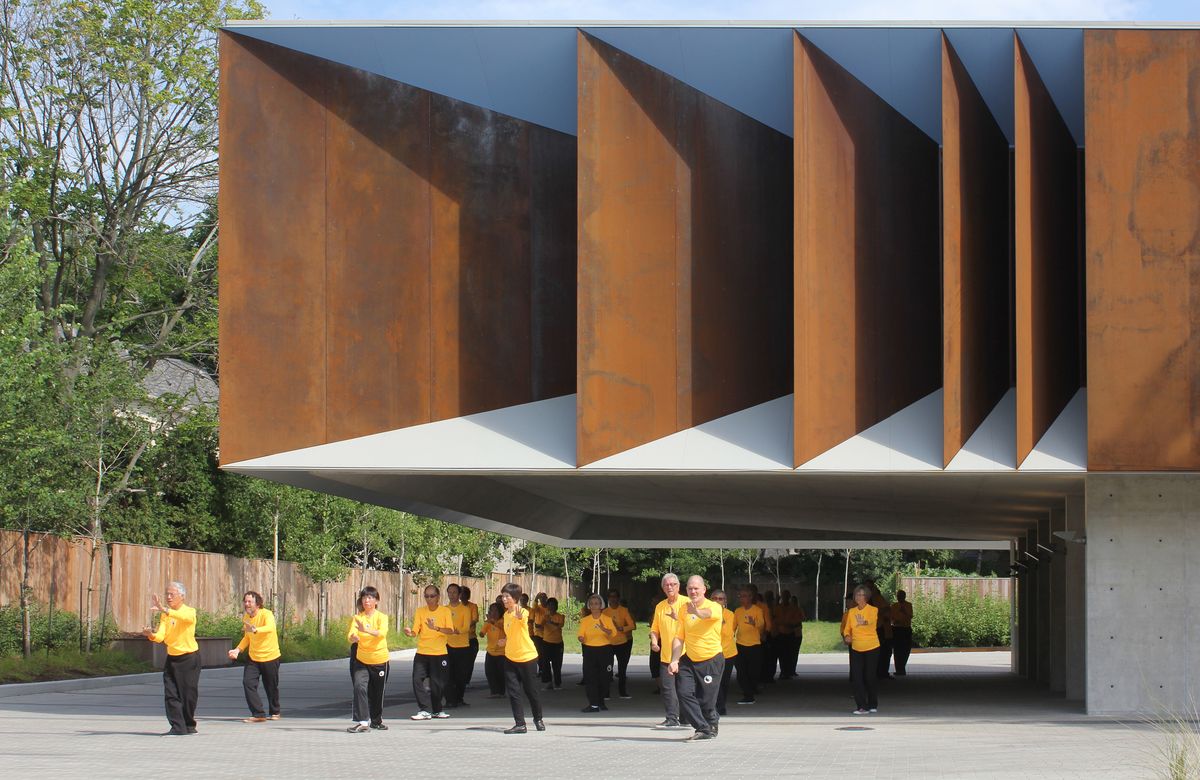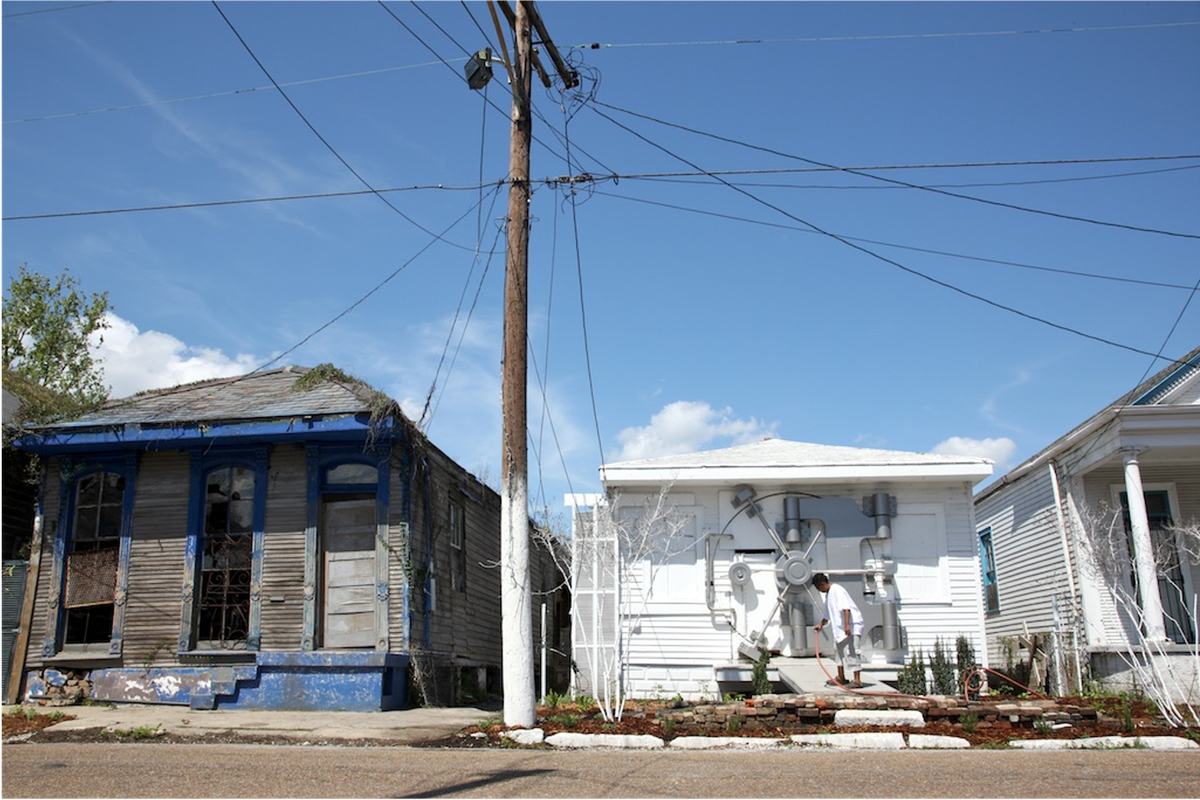An inverted map shows Tasmania at the top of the world. Peta Heffernan (Liminal Studio) is interested in Tasmania’s geographical disconnect – and in the “metaphorical space” it makes for the intensified creativity that comes from dwelling on the fringe. John Wardle (Wardle) is fascinated with the “cultural canniness” found on the island, and he fondly speaks of a watering can made out of an old paint tin: evidence of the ingenuity of local makers with limited access to resources. Together, these two have curated a rigorous yet intentionally broad framework for this Design Speaks symposium, aptly named “Ideas from the Fringe” and – most appropriately – hosted in Hobart.
The one-day symposium was bookended by international guests Kevin Low (Small Projects, Malaysia) and Brigitte Shim (Shim-Sutcliffe Architects, Canada). They shared a strong focus on the making of 1:1 architectural detail in their projects, but their contrasting tones reflected their geographical locations: Low’s porous, cross-ventilated spaces in the golden light of tropical surrounds and Shim’s hermetically sealed building envelopes in the cool light of blizzardy photoshoots. Both came as direct responses to climate.
Low started with what he called “small-project fringe:” a chaise lounge that ingeniously folds down to become an access ramp, solving an entry-sequence design puzzle of levels and access in a single move; and a chapel made with a circular field of 10-millimetre rebar columns (a commonly available local material). These are beautiful examples of design resourcefulness, of simple materials assembled in a deeply thoughtful manner. “Operational fringe” describes Low’s practice: working alone in a loose-yet-rigorous manner, drawing each detail on its own piece of paper as he would an artwork – albeit on the back of a recycled A4 page. These exquisite drawings are as sumptuous as the tropical modernist spaces he has crafted, and they come from a deep interrogation of local context and pragmatic detail.
Ravine Guest House by Shim Sutcliffe.
Image: Raimund Koch
Shim works with a more determined precision, which is evidenced in early projects. The Ravine Guest House investigated craft and detail, simultaneously establishing an interest in “Canadian-ness” that has continued across the practice’s body of work. As the projects presented grew in budget and scale, the fascination with intricate details was ever-present – but to me, the 10-metre cantilever in the Wong Dai Sin Temple felt excessive rather than impressive, straying from the undertone of the symposium of doing more with less.
Five Mile Radius (Brisbane) has built its practice around the ethics of making. Using waste as a resource to create new building products has spawned opportunities in unexpected places; beautiful ripple blocks made from overpour concrete, formed with offcuts of “ripple iron,” were installed in Aēsop shops across Brisbane. Informed by a strong emerging design language – and by a desire to value resources as much as possible – director Clare Kennedy is “on board to hoard.” The grassroots approach was refreshingly optimistic, especially when pictured against the vast wastefulness of the building industry. The team’s resourcefulness resonated with Wardle’s fascination with the innovative, low-tech maker.
Ripple blocks of overpour by Five Mile Radius installed at Aesop stores in Brisbane.
Image: Courtesy Five Mile Radius
The duo of Archier director Chris Gilbert and Jas Johnston (Candour) pitched a soon-to-be-released design-to-manufacture system made by architects for architects. By tapping into the burgeoning world of timber prefabrication, Candour offers custom floor cassettes, roofs and structural facade systems. Having recently used some of these components in my own projects, I absolutely see the usefulness of an efficient, cost-effective process that encourages use of low-carbon materials with minimal waste. Archier’s beautiful Five Yards House, a pioneer of the system, was convincing for anyone still in doubt. The presentation, which focused on the innovation of the tool, sat at the opposite side of the room from the handmade conversation.
Five Yard House by Archier was built using technology developed by Candour.
Image: Adam Gibson
For Jacob Nash, the fringe doesn’t exist. “Truth sits in the centre of me,” he explains, reflecting his need to reconnect to Country and decolonize his own history. The rejection of the fringe comes out of navigating the space between First Nations culture and Western convention. By locating himself in the centre, Nash defines his practice.
Nash has been the design director at Bangarra Dance Theatre for the last 12 years. He reflected on Artefact, his first design for the company. To fulfil the artistic director’s complex vision of object and meaning, Nash meticulously constructed an analogue of a piece of bark – apparently simple, but in fact a highly technical project with multiple design challenges. Artefact became a stage device to hold story. Able to be suspended and projected upon, it also had to be light enough to be carried by the dancers, and strong enough to bear their weight. And, metaphorically, it acted as a place of kinship and knowledge.
Nash’s honest reflection on his own practice made his story both intimate and profound.
Artefact by Jacob Nash is an analogue for a piece of bark, used as a stage device to hold the story.
Image: Courtesy Jacob Nash
In the afternoon, Rufus Black (vice-chancellor at the University of Tasmania) delivered the most eloquent punch in the guts, shaking up the profession with the indisputable facts of climate change in a succinct call to arms. He drew a graph showing the exponential growth of carbon emissions caused by the built environment, before asking, “Is it ethical for architects to design expansive houses that require an inordinate amount of material, when massive inequities in living conditions exist elsewhere?”
The opportunity exists for architecture to lead the conversation in a net-zero-carbon, circular economy world – but it would require a massive turnaround in our current processes, with immediate effect. Simply put, we’re not doing enough and time is running out.
AJ King (Ochre-Rain) intertwined his personal story with a detailed account of Country, sharing his mob’s recent history, including how they resisted invasion for 50 years before being incarcerated. It is clear that the pain of atrocities remains close to the surface, but King displayed an emotional intelligence rarely seen in a public forum; the fragility of his words held the room in intimate quarters.
Reclamation Walk at Dark Mofo in 2021.
Image: Jiayuan Liang via Xplorer Studio
King’s tips on acknowledging Country gave insight into how to tell a story about Country (rather than following a script). Pause. Acknowledge. Remember. Connection. Commitment. His own acknowledgment painted a detailed picture of the lives of the site’s Traditional Custodians, where they lived on the shore of the creeks and rivulets. He remembers the death of William Lanne, whose remains were desecrated (figuratively , not actually) under the concrete footings of the auditorium where we gathered. The story of us gathering for the Architecture Symposium in this place was recognized as the latest chapter in our connection to Country. Finally, King spoke about accepting the ongoing responsibility to share contemporary stories and how this forms part of our commitment to truthfully tell stories about Country.
The day’s wildcard, US-born Kirsha Kaechele – art curator, marijuana farmer and self-acknowledged partner in crime of professional gambler David Walsh (MONA), truly transported us to another world. Kaechele took us to a post-Katrina New Orleans and into site-specific installations in six abandoned houses across a suburban block, including a facade replaced by a bank vault door to create a “safe house.” It’s at this fringe where a project’s social impact can be painted in stark relief, where the power of ideas to drive change is most evident. Kaechele is at times haphazard, at times brilliant, but always precisely culturally located. Also in New Orleans, she ran a gun buyback in a notorious car wash, where money made from the Tasmanian-inspired gun buyback was used to establish a recording studio (Gun Metal Records) that encouraged youth in the suburb of St Roch to trade violence for talent. Keachele uses the theatre of her projects to catalyze a social movement, while committing to an ongoing legacy to rebuild community.
Kirsha Kaechele installation in post-hurricane New Orleans.
Image: Courtesy Kirsha Kaechele
On the day following the symposium, a curious group hopped on board the ferry for a trip to Bruny Island. After curating a symposium, it must be extremely confronting to open your home to the delegates. But it was with the most generous spirit that John Wardle did just this. The buses dropped us at the top of the hill, allowing for a full survey of the site, with its extraordinary outlook to Storm Bay. Watching the largely black-clad cohort saunter down the track under the crisp Tasmanian sun reminded me how urban we have become as a species. But everyone seemed mesmerized to finally be standing in a place we know so well through pictures. The experience of being on Country, of feeling the siting of the buildings in their landscape, was an utterly gratifying experience.
Delegates of The Architecture Symposium:Ideas from the fringe sit on the verandah of John Wardle’s Captain Kelly’s Cottage.
Image: Kevin Low
Everything looks sharper in the Tasmanian light. The sparkling galvanized corrugated steel of the Shearer’s Quarters (Australian House of the Year in 2012) against the crystalline deep turquoise of the sea set the perfect scene for the architecture paparazzi to launch into a frenzied race to document every last detail of the work. Thanks to the Bruny Island Country Women’s Assocation, we were brought back to earth with a proper lunch in a proper woolshed.
If “necessity is the father of invention,” it could be argued that excesses in consumption, wealth and house sizes have led us to misplace the gift of our profession. It made me think of the paint-tin watering can and how far we have strayed. Seeking some closure for the weekend, I managed to catch up with John Wardle on the way to the woolshed, who delivered:
“Architects don’t have as much power as we’d like to – we can’t single-handedly solve all the world’s problems. But by small measures, we can do things that are profound. Using the power we do have, we can provide signals of innovation that will guide others on a broader platform. We are in a fascinating time of catching up, a fascinating time for practitioners – Country and climate change are defining this era of architecture.”
The Architecture Symposium: Ideas from the Fringe is a Design Speaks program organized by Architecture Media, publisher of ArchitectureAU.com, and supported by Brickworks, Cusp and the University of Tasmania.

